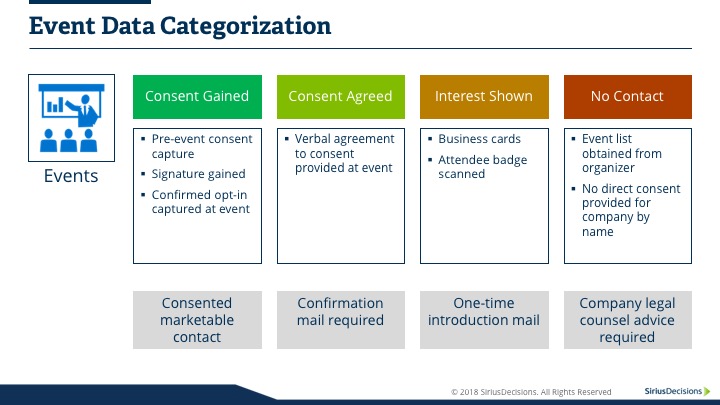Consent Capture: Four Categories of In-Person Event Data
- GDPR is now a fact of life, and personal data privacy is not going away
- Investing in event contact capture capabilities can ensure effective and compliant growth of your company’s contact database
- Employees from the sales and marketing teams must play an active role in capturing contact consent
In the days leading up to the GDPR compliance deadline in May, a great deal of attention was placed on capturing consent via two practical and logical methods: email and Web forms. However, another, less frequently discussed method, in-person events, offers sales and marketing teams the opportunity to leverage in-person events for direct face-to-face consent capture. 
Event contact capture is just one port of entry for data entering sales and marketing systems, and when organizations are looking for consent, not all data is created equal. Smart segmentation of the data that companies acquire (e.g. via registration, badge scans, business card exchange, organizer lists) helps collect quality contextual data for the marketing database, and ensures that the data is compliant at the time of entry and for future processing. The four major segments of event contact information are:
- Consent gained. If a trade show organizer requested and received consent on behalf of the company (i.e. the registration consent sign-up form directly named the company), or data subjects signed up for a live event via a landing page created and owned by the company, this is valid consent. Some event contacts will already be pre-consented from other actions and known to you – again, this is all good! Many companies undertake employee booth staff training, redesign contact capture forms (both physical and electronic), and ensure that any conversation with visitors includes a request to consent to receive marketing communication. To show unambiguous proof of consent, consider sending a confirmation mail to the data subject (along the same lines of what is commonly known as the confirmed or double opt-in process). When a data subject selects “yes,” an employee will mark a field that triggers an email to be sent to the subject’s inbox and the person can then click the link while at the booth. Some organizations use at-event apps that allow for the subject to collect the electronic signature at the booth.
- Consent agreed. During a booth conversation, a data subject may verbally consent, but delay providing the confirmation. Monitor this situation and work with legal counsel to agree to a cadence of permissible follow-up actions (e.g. one or two reminder emails to drive conversion). Another scenario is where a sales rep has been given a business card in person and the subject has requested information. Naturally, the rep will follow up; however, this person has not consented to receive ongoing marketing communication. To place the contact in the marketing database compliantly and be able to continue to market to that person, both now and in the future, the organization must establish a process to secure the opt-in consent of the contact. Again, consider asking for consent immediately or sending that person a follow-up mail asking for consent.
- Interest shown. Other contact data capture often comes via semi-, non-personal interaction, badge scans and/or names collected via business cards given to win a prize. Once again, the issue is that consent to receive marketing communication has not been given. Additionally, the actions are related to the event itself and therefore, any presumed consent expires with the end of the event. I suggest gaining agreement from your legal counsel to be allowed to send follow-up mails on the basis of presumed interest and ask for consent.
- No contact. The instances of an event organizer providing sponsors with participant lists are less frequent. In this scenario, marketing teams would be gaining data to which the lawful basis to process would be questionable, unless the company’s lawyers concede that this is perhaps legitimate interest. Again, I would urge companies to seek guidance and confirmation that a one-time mail can be sent or, if appropriate, use teleservices and ask for consent.

The responsibility of consent does not just lie with marketing. Other functions such as sales, teleservices and channel employees must contribute to expanding the addressable marketing contact database. Provided that the people, process and technology are in place, there is no better opportunity for each team member to play his or her part in delivering those all-important opt-ins than in-person events.
